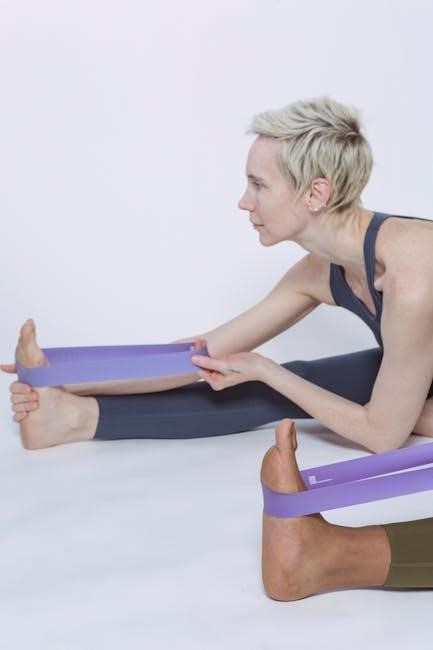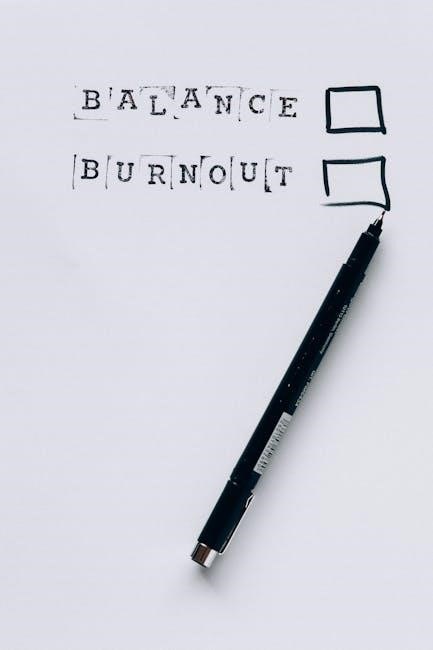Overview of IT Band Syndrome
IT band syndrome is a common overuse injury, frequently affecting runners and cyclists. It occurs due to hip weakness and repetitive stress on the iliotibial band, a thick fascia running from the hip to the knee, which plays a crucial role in hip extension, abduction, and knee stabilization during movement.
1.1 Definition and Prevalence
IT band syndrome (ITBS) is an overuse injury causing lateral knee pain due to inflammation of the iliotibial band. It is highly prevalent among runners, cyclists, and hikers, often resulting from repetitive knee flexion and extension. The condition is common in sports requiring frequent knee bending, affecting both amateur and professional athletes;
1.2 Key Roles of the IT Band
The iliotibial band (IT band) is a thick fascia extending from the hip to the knee, stabilizing the knee and aiding in hip extension, abduction, and rotation. It protects the outer thigh and supports movement during activities like running, cycling, and walking, playing a vital role in lower limb mechanics and pelvic alignment during physical activities.
Causes and Risk Factors
IT band syndrome is an overuse injury often caused by repetitive stress and hip weakness, commonly affecting runners and cyclists during intense physical activities.
2.1 Overuse and Repetitive Stress
Overuse and repetitive stress are primary causes of IT band syndrome, often occurring in runners, cyclists, and hikers. Activities involving repetitive knee bending or hip rotation create friction, leading to inflammation and pain along the IT band. Prolonged or intense movements exacerbate this condition, making it a common issue in endurance sports. The American Association of Hip and Knee Surgeons (AAHKS) highlights repetitive stress as a key factor in ITBS development.
2.2 Hip Weakness and Misalignment
Hip weakness and misalignment are significant contributors to IT band syndrome. Weakness in the hip abductors and tensor fasciae latae (TFL) muscles can lead to poor movement patterns, increasing friction on the IT band. Misalignment issues, such as uneven pelvis or gait irregularities, further exacerbate the strain, causing inflammation and pain during activities like running or cycling. Addressing these imbalances is crucial for recovery and prevention.
2.3 Common Activities Leading to ITBS
Running, cycling, and hiking are primary activities linked to IT band syndrome. Repetitive knee bending and hip flexion create friction, straining the IT band. Overuse in sports like distance running or sudden increases in activity intensity often trigger symptoms. Activities involving repetitive lateral movements or uneven terrain further exacerbate the risk of developing ITBS.
Symptoms of IT Band Syndrome
IT band syndrome typically causes sharp pain on the outer thigh or knee, worsening with activities like running or cycling. Swelling and limited mobility may also occur.
3.1 Pain Location and Characteristics
Pain from IT band syndrome is typically felt on the outer thigh or near the knee. It often presents as a sharp, stabbing sensation that worsens during activities like running or cycling. The discomfort may radiate along the lateral thigh and can be accompanied by swelling or tenderness to the touch, especially near the knee joint. Activities that involve repetitive knee flexion or extension tend to exacerbate the symptoms, making movement uncomfortable for affected individuals.
3.2 Aggravating Activities
Activities that involve repetitive knee flexion, such as running, cycling, or downhill walking, often worsen IT band syndrome. Sudden increases in exercise intensity or mileage can also aggravate symptoms. Additionally, sports requiring frequent knee bending, like basketball or volleyball, may exacerbate pain. Avoiding or modifying these activities is crucial to aid recovery and reduce discomfort. Rest and targeted stretching are recommended to alleviate symptoms.
3.3 Swelling and Limited Mobility
Swelling around the knee or thigh is common in severe IT band syndrome cases, often accompanied by limited mobility. Painful inflammation restricts movement, making activities like walking or climbing stairs difficult. Reducing swelling through ice therapy and compression can help restore mobility. Gentle stretching and rest are essential to prevent further irritation and promote healing of the affected area effectively.

Diagnosis and Assessment
Diagnosis involves physical exams to assess pain and swelling. Imaging tests like X-rays or MRIs confirm ITBS, ruling out other knee issues.
4.1 Physical Examination Techniques
A physical exam for ITBS typically includes palpation of the IT band to check for tenderness. The Ober test and Renne’s test are commonly used to assess tightness and irritation. The examiner may also evaluate swelling, pain during specific movements, and limited hip or knee mobility to confirm the diagnosis and rule out other conditions.
4.2 Imaging and Additional Tests
Imaging such as MRI or ultrasound may be used to confirm ITBS diagnosis, especially when symptoms persist or the cause is unclear. These tests help rule out other conditions like meniscal tears or stress fractures. Additional assessments may include gait analysis or biomechanical evaluations to identify contributing factors, ensuring an accurate diagnosis and appropriate treatment plan.

Importance of Stretching and Strengthening
Stretching and strengthening are crucial for ITBS recovery, addressing tightness and muscle imbalances while improving flexibility and hip stability to prevent future episodes and support overall recovery.
5.1 Role of Stretching in ITBS Recovery
Stretching plays a vital role in ITBS recovery by reducing tension in the iliotibial band and improving flexibility. Regular stretches, such as standing and side-leaning IT band stretches, help alleviate pain and restore range of motion. These exercises target the IT band and surrounding muscles, promoting healing and preventing recurrence. Consistency is key for optimal recovery and mobility.
5.2 Benefits of Strengthening Exercises
Strengthening exercises address muscle imbalances and hip weakness in ITBS. They reduce IT band strain, improve joint stability, and enhance lower limb function. Targeting the glutes, core, and hip abductors restores movement patterns and prevents recurrence, reducing injury risk.

Effective IT Band Stretches
Effective IT band stretches include standing, side-leaning, and supine hip rotation stretches, targeting the outer thigh and hip to relieve tension and pain.
6.1 Standing IT Band Stretch
The standing IT band stretch involves crossing one leg in front of the other, bending down to touch the toes, and stretching the upper body sideways. This stretch targets the outer thigh and hip, helping to relieve tension and pain. It is essential to maintain a straight line and avoid bending the hips for maximum effectiveness. Regular practice can improve flexibility and reduce discomfort associated with IT band syndrome.
6.2 Side-Leaning IT Band Stretch
Stand sideways to a wall with your injured leg toward the inside. Place your nearest hand on the wall for support. Lean away from the wall, stretching the outer thigh. Keep your body straight and avoid bending your hips. Hold the stretch for 30 seconds and repeat. This stretch effectively reduces IT band tightness and alleviates pain when performed regularly.
6.3 Supine Hip Rotation Stretch
Lie on your back with legs straight. Cross your injured leg over the other, placing your foot on the opposite knee. Gently push the knee toward your chest until a stretch is felt on the outer thigh. Keep your spine neutral and hold for 30 seconds. Repeat twice daily to improve flexibility and reduce IT band tension.

Strengthening Exercises for ITBS
Strengthening exercises target hip muscles, glutes, and core to address weakness contributing to ITBS. They improve hip stability and reduce repetitive stress on the IT band during activities.
7.1 Hip Abduction and Extension Exercises
Hip abduction and extension exercises strengthen the glutes and Tensor Fasciae Latae, key muscles for hip stability. These exercises, such as side-lying leg lifts and prone hip extensions, improve posterior chain strength, reducing IT band tension and enhancing movement efficiency during activities like running or cycling.
7.2 Core Stability and Glute Strengthening
Strengthening the glutes and core enhances pelvic stability and reduces IT band tension. Exercises like bird dogs, bridges, and clamshells target these muscles, improving running mechanics and overall lower limb alignment. Stronger glutes help maintain proper hip and knee positioning, reducing overuse stress on the IT band during repetitive activities like cycling or running.

Exercises to Avoid
High-impact activities like running and repetitive knee movements should be avoided, as they can increase IT band friction and inflammation, worsening symptoms and slowing recovery.
8.1 High-Impact Activities to Limit
High-impact activities, such as running, cycling, and jumping, should be limited during ITBS recovery. These movements cause repetitive stress on the iliotibial band, exacerbating irritation and pain. Avoiding such exercises helps reduce inflammation and promotes healing. Instead, opt for low-impact alternatives like swimming or elliptical workouts to maintain fitness without aggravating the condition.
8.2 Movements That Exacerbate Symptoms
Movements that involve repetitive knee flexion, such as running, cycling, or repetitive bending, can worsen ITBS symptoms. Activities requiring sudden changes in direction or downhill walking also increase friction on the IT band, leading to pain. Prolonged standing or exercises involving repetitive hip abduction should be avoided to prevent further irritation and inflammation of the affected area.
Foam Rolling and Self-Myofascial Release
Foam rolling and self-myofascial release reduce IT band tension and pain. Techniques involve rolling from the hip to just above the knee, using pressure to relieve tightness. Regular use complements stretching and strengthens the surrounding muscles, aiding recovery and preventing future episodes.
9.1 Techniques for IT Band Foam Rolling
Start by lying on the floor with the foam roller placed under the outer thigh. Slowly roll from the hip to just above the knee, applying moderate pressure. Use the other leg and hand to offload pressure as needed. Keep the body in a straight line, avoiding hip bending. Repeat the motion to relieve tightness and pain along the IT band.
9.2 Benefits of Regular Foam Rolling
Regular foam rolling reduces muscle tightness and improves circulation, targeting the IT band effectively. It helps alleviate pain and inflammation, enhances mobility, and prevents future episodes of ITBS. Consistent use also breaks down adhesions in the fascia, promoting smoother muscle function and overall recovery, making it a valuable tool for both prevention and treatment of IT band syndrome.

Rest and Recovery Strategies
Rest is crucial to reduce inflammation and pain. Ice therapy numbs the area, while compression provides support. Avoiding aggravating activities allows the IT band to heal properly.
10.1 Ice Therapy and Compression
Ice therapy helps reduce inflammation and numb pain in the affected area. Apply ice for 15–20 minutes, several times daily. Compression, such as elastic bandages or sleeves, provides support and reduces swelling. These methods, combined with rest, promote healing and alleviate discomfort associated with IT band syndrome.
10.2 Activity Modification for Healing
Activity modification is crucial to allow the IT band to heal. Avoid high-impact activities like running or cycling, which can worsen symptoms. Replace them with low-impact exercises such as swimming or cycling on a stationary bike. Reducing repetitive stress helps prevent further irritation and promotes recovery. Gradually reintroduce activities once symptoms improve, ensuring proper warm-up and cool-down routines.
When to Seek Professional Help
Persistent pain and severe symptoms, such as significant swelling or limited mobility, indicate the need for professional medical advice. Consult a specialist if self-care measures fail.
11.1 Persistent Pain and Limited Progress
If pain persists despite consistent stretching and strengthening exercises, seek professional help. Limited progress may indicate underlying issues requiring medical intervention, such as physical therapy or advanced treatments, to address severe IT band damage effectively and prevent further complications.
11.2 Signs of Severe IT Band Damage
Severe IT band damage is marked by intense pain, significant swelling, and limited mobility. If symptoms persist or worsen despite rest and treatment, or if a snapping or popping sensation occurs, consult a healthcare professional for proper diagnosis and advanced treatment options to address the underlying tissue damage effectively.
Preventing Future Episodes
Preventing ITBS involves regular stretching and strengthening exercises, focusing on hip and core muscles. A consistent routine helps maintain flexibility and strength, reducing recurrence risk.
12.1 Long-Term Stretching Routine
A consistent stretching routine targeting the IT band, hip flexors, and glutes is essential. Standing and side-leaning stretches, along with supine hip rotations, should be performed 2-3 times weekly. Holding each stretch for 20-30 seconds ensures optimal flexibility and reduces the risk of future episodes. Regular practice helps maintain range of motion and prevents tightness.
12.2 Maintaining Hip and Core Strength
Strengthening the hips, glutes, and core is vital for long-term prevention of ITBS. Exercises like hip abduction, extension, and core stability workouts should be done 2-3 times weekly. Stronger hip muscles improve running mechanics and reduce repetitive strain on the IT band, fostering better overall lower limb alignment and balance during physical activities.
Proper stretching, strengthening, and rest are key to managing ITBS. Consistent use of targeted exercises, like standing IT band stretches and hip abduction workouts, can prevent future episodes. While home treatment is effective, persistent pain warrants professional intervention. Prioritizing hip and core strength, along with regular stretching, ensures long-term recovery and enhances overall athletic performance and mobility.


